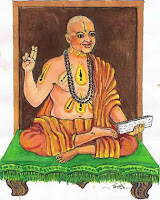Trayacharyas (the trinity of philosophers) influenced Indian thoughts after the ages of the Vedas and Puranas.
The manner in which Varaaha Murthy viewed the Trayacharyas is unique. Below, I reproduce the script mirroring his interpretation of Madhwacharya, the propounder of Dwaita Siddhanta (philosophy). Even the graphic supporting the script is an artwork by Varaha.
Madhvacharya was born to Madhyageha Bhatta in the village Paajaka near Mangalore. Parents named him Vasudeva and later he was named Poorna Prajnya and Anandateertha by his masters. As a young child, Vasudeva exhibited many miraculous powers. As a boy, he spent several days alone in Narayana temple, in the forest surrounding Kadavasal village, Nagapattinam district in Tamil Nadu, India.
After Upanayana he had to study under the care of a priest. Vasudeva spent most of his time in running, wrestling and swimming, rather than attending classes. When teachers objected, he proved before them that he knew all that was taught in the school and also pointed out where the teacher had to improve himself knowledge-wise.
At the age of sixteen, Vasudeva took Sanyasa Deeksha (monastic vows) from Achyutapreksha, the pontiff of a monastery at Kaare near Udupi. He was given a new name Poorna Prajnya. The new ascetic began to receive instructions in the doctrines of Advaitha. Very soon serious differences cropped up between the teacher and the disciple.
The teacher was astonished at the sharp memory and remarkable scholarship of his student. He gave his student another name, Anandathirtha, and made him the pontiff of his monastery. Madhava, the synonym of his real name became more common and popular, as he is well known as Madhvacharya. Madhvacharya was a giant both physically and intellectually. His yogic power added to his personality.
Many scholars who were arrogant because of their learning, challenged Madhvacharya. They had to accept defeat against the knowledge, power of argument and analysis of ancient scriptures by Madhvacharya. They subsequently converted themselves to his views.
During his pilgrimage to South India, in one of his meetings, he was challenged by some scholars to explain the scriptures. They were taken aback when he said that each Vedic Sukta had three meanings, the Mahabharata had ten, and each name in the Vishnu Sahasranama had a hundred meanings. Madhvacharya showed the challengers that what he said was far from dispute.
His confrontation with the scholars of various schools, like those of Shankara and Ramanuja, convinced him of the need for a new school of thought regarding Vedantha. It is said that he visited the famous pilgrimage – Badrinath, where he spent time even around inaccessible regions of upper Badri, met Vedavyasa who lived there with his disciples invisible to ordinary human beings. It is also said that he received his instructions about Brahma Sutra, Mahabharata and Pancharathra Agama, which has established the glory of Narayana. Then he wrote his commentary on Brahma Sutra and Travelled back to South India.
In South India, two great scholars Shobhana Bhatta of Godavari region and Swamy Shastri from Kalinga accepted Madhvacharya’s views on Vedantha and became Sanyasis. They were renamed Padma Nabha Teertha and Narahari Teertha. They, later on, wrote commentaries on the works of Madhvacharya.
Achyutha Preksha, who was his Guru, accepted the views of his student and became the disciple of his own pupil. During his stay in Udupi, he came across a huge lump of mud (Gopichandana). He carefully removed the mud and washed it in a nearby lake and was overjoyed as the lump assumed the beautiful idol of Sri Krishna. He personally carried the idol to his monastery. He was so inspired that he composed Dwadasha Stotra on Vasudeva. The hymn refers to the idol. It says that the idol was carved out by the divine architect and sculptor Viswakarma and it was worshiped by Gopis of Brindavan and also by the queen Rukmini.
It is very important that he brought about a great healthy reform in sacrificial rites. He introduced animal forms made of a paste of black gram powder and ghee instead of real animals and included them in devotional disciplines. During his second pilgrimage to Badri, it is said that he performed many miracles which show that he was a giant in yogic powers. When he was staying in Udupi, the manuscript of his works was stolen by rival scholars but was recovered those in a miraculous way.
During this period he won over a great scholar – Trivikrama Panditha. Trivikrama Panditha later wrote an elaborate commentary on Brahmasutra Bhashya of the Acharya.
He established a temple of Lord Krishna at Udupi and arranged for unhindered worship to go on. He gave the responsibility to eight Sanyasis who were his disciples, fully satisfied with the work he had done throughout his life. Madhvacharya mysteriously disappeared from his seat while teaching Aitareya Upanishad to his disciples, leaving a bouquet of flowers on the seat. He left behind a vast treasure of his works.
Madhvacharya advocated dualism and realism. His philosophy accepts Pancha bhedas or five kinds of difference which are real and permanent. They are: God is different from the soul; He is also different from nature; various kinds of nature are different from one another; various souls are different from one another.
The great successors of Madhvacharya have kept the Dwaita Vedanta philosophy alive. Jaya Teertha, Vyasaraya, and Raghavendra were the most popular saints amongst those who propagated Dwaitha Siddhanta. Dasakoota has nourished the tradition of Bhakti (Devotion to God Krishna, Narayana or Vishnu).
* * * * *
Opinion
[22/07, 11:08] C T Joshi: Acharya Madhwa is one of the three super religious leaders of Hinduism known particularly for his propagation of Bhakti maarga (devotional path to spiritual deliverance).His contribution in sustaining Hinduism is as great as of the other two of trinity of Hindu spiritual leaders Acharya Shankara and Acharya Ramanuja. But unfortunately he is not as well-known as the other two.






Great
ReplyDelete